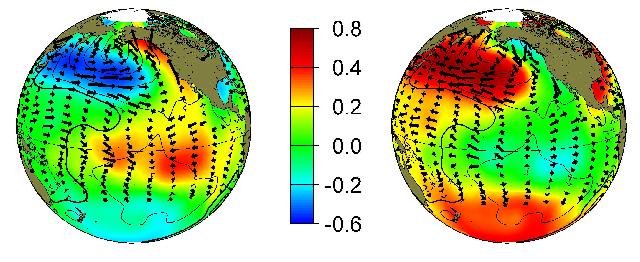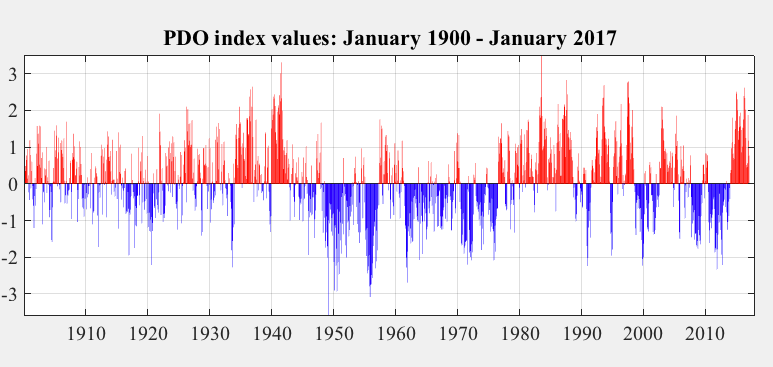PDO Index Monthly Values:January
1900-present
JISAO
data
PDO
in the media (links to articles, collected by Steven Hare)
PDO graphics
The Pacific Decadal Oscillation (PDO)
Typical wintertime Sea Surface Temperature (colors),
Sea Level Pressure (contours) and surface windstress
(arrows) anomaly patterns during warm and cool phases of PDO
warm phase
cool phase


The "Pacific Decadal Oscillation" (PDO) is a long-lived
El Niño-like pattern of Pacific climate variability. While the two
climate oscillations have similar spatial climate fingerprints, they have
very different behavior in time. Fisheries scientist Steven Hare coined
the term "Pacific Decadal Oscillation" (PDO) in 1996 while researching
connections between Alaska salmon production cycles and Pacific climate
(his dissertation topic with advisor Robert Francis). Two main characteristics
distinguish PDO from El Niño/Southern Oscillation (ENSO): first,
20th century PDO "events" persisted for 20-to-30 years, while typical ENSO
events persisted for 6 to 18 months; second, the climatic fingerprints
of the PDO are most visible in the North Pacific/North American sector,
while secondary signatures exist in the tropics - the opposite is true
for ENSO. Several independent studies find evidence for just two full PDO
cycles in the past century: "cool" PDO regimes prevailed from 1890-1924
and again from 1947-1976, while "warm" PDO regimes dominated from 1925-1946
and from 1977 through (at least) the mid-1990's. Shoshiro Minobe
has shown that 20th century PDO fluctuations were most energetic in two
general periodicities, one from 15-to-25 years, and the other from 50-to-70
years.
http://ingrid.ldeo.columbia.edu/%28/home/alexeyk/mydata/TSsvd.in%29readfile/.SST/.PDO/
Major changes in northeast Pacific marine ecosystems
have been correlated with phase changes in the PDO; warm eras have seen
enhanced coastal ocean biological productivity in Alaska and inhibited
productivity off the west coast of the contiguous United States, while
cold PDO eras have seen the opposite north-south pattern of marine ecosystem
productivity.
Causes for the PDO are not currently known. Likewise,
the potential predictability for this climate oscillation are not known.
Some climate simulation models produce PDO-like oscillations, although
often for different reasons. The mechanisms giving rise to PDO will determine
whether skillful decades-long PDO climate predictions are possible. For
example, if PDO arises from air-sea interactions that require 10 year ocean
adjustment times, then aspects of the phenomenon will (in theory) be predictable
at lead times of up to 10 years. Even in the absence of a theoretical understanding,
PDO climate information improves season-to-season and year-to-year climate
forecasts for North America because of its strong tendency for multi-season
and multi-year persistence. From a societal impacts perspective, recognition
of PDO is important because it shows that "normal" climate conditions can
vary over time periods comparable to the length of a human's lifetime .
Data
The Pacific Decadal Oscillation (PDO) Index is defined as the leading principal
component of North Pacific monthly sea surface temperature variability
(poleward of 20N for the 1900-93 period). Digital values of our PDO index
are available from Nate Mantua's anonymous ftp directory
(linked
here). Please send email to Nate (nate.mantua@noaa.gov)
or Steven Hare (hare@iphc.washington.edu)
to let them know that you have obtained this data. Nate updates the PDO
index every two or three months.
Alexey Kaplan's PDO reconstructions for 1856-1991:
SST
and
SLP
A link to Trenberth and Hurrel's "North
Pacific Index" for North Pacific area-weighted sea level pressure (a
good index for the intensity of the Aleutian Low pressure cell). More information
on this index and its importance to North Pacific and North American climate
is detailed in Trenberth and Hurrell (1994): Decadal atmosphere-ocean variations
in the Pacific. Climate Dynamics, Vol. 9, p 303-319.
Steven Hare's collection of links to Pacific
fishery and climate time series.
NOAA's Climate Diagnostics Center interactive correlation
maps, with links to many other climate indices (like the SOI, AO, NAO,
etc.)
The Aleutian
Low Pressure Index (ALPI) from Canada's Pacific Biological Station.
Key References to PDO research
Barnett, T. P., D. W. Pierce, M. Latif, D. Dommenget, and R. Saravanan.
1999. Interdecadal interactions between the tropics and midlatitudes
in the Pacific basin. Geophys. Res. Lett. 26: 615-618.
Beamish, R.J. 1993: Climate and exceptional fish production off the
west coast of North America. Can. J. Fish. Aquat.
Sci., 50, 2270-2291.
Bond, N.A. and D.E. Harrison (2000): The Pacific Decadal Oscillation,
air-sea interaction and central north Pacific winter atmospheric regimes.
Geophys. Res. Lett., 27(5), 731-734.
Francis, R. C. and S.R. Hare. 1994. Decadal-scale
regime shifts in the large marine ecosystems of the Northeast Pacific:
a case for historical science. Fish. Oceanogr. 3: 279-291.
Francis, R. C., S. R. Hare, A. B. Hollowed, and W. S. Wooster. 1998.
Effects of interdecadal climate variability on the oceanic ecosystems of
the NE Pacific. Fish. Oceanogr. 7: 1-21.
Gershunov, A. and T. P. Barnett. Interdecadal modulation of ENSO
teleconnections. Bull. Amer. Meteor. Soc. 79: 2715-2725.
Graham, N.E., 1994: Decadal-scale climate variability in the tropical
and North Pacific during the 1970s and 1980s:
Observations and model results. Clim. Dyn. 10, 135-162
Hare, S. R. and N. J. Mantua. In Press. Empirical evidence
for Northeast Pacific regime shifts in 1977 and 1989. Prog. Oceanogr.
Hare, S. R., N. J. Mantua and R. C. Francis. 1999. Inverse
production regimes: Alaskan and West Coast Salmon. Fisheries 24(1):6-14.
Hare, S.R. and R.C. Francis. 1995. Climate
Change and Salmon Production in the Northeast Pacific Ocean. In: R.J.
Beamish [ed.] Ocean climate and northern fish populations. Can. spec.
Pub. Fish. Aquat. Sci. 121, pp. 357-372.
Latif, M. and T.P. Barnett, 1994: Causes of decadal climate variability
over the North Pacific and North America.
Science 266, 634-637.
Mantua, N.J. and S.R. Hare, Y. Zhang, J.M. Wallace, and R.C. Francis
1997: A
Pacific interdecadal climate oscillation with impacts on salmon production.
Bulletin of the American Meteorological Society, 78, pp. 1069-1079.
Miller, A.J., D.R. Cayan, T.P. Barnett, N.E. Graham and J.M. Oberhuber,
1994: The 1976-77 climate shift of the Pacific
Ocean. Oceanography 7, 21-26.
Minobe, S. 1997: A 50-70 year climatic oscillation over the North Pacific
and North America. Geophysical Research
Letters, Vol 24, pp 683-686.
Minobe, S. Resonance in bidecadal and pentadecadal climate oscillations
over the North Pacific: Role in climatic regime shifts. Geophys.
Res. Lett.26: 855-858.
Nigam, S., M. Barlow, and E. H. Berbery, 1999: Analysis Links
Pacific Decadal Variability to Drought and Streamflow in United States.
EOS, Vol. 80, No. 61. (html
version)
Overland, J.E., S. Salo, and J.M. Adams (1999): Salinity signature of
the Pacific Decadal Oscillation. Geophys. Res. Lett., 26(9), 1337-1340.
Trenberth, K.E., 1990: Recent observed interdecadal climate changes
in the northern hemisphere. Bulletin of the American
Meteorological Society, 71, 988-993.
Trenberth, K.E. and J.W. Hurrell, 1994: Decadal atmosphere-ocean variations
in the Pacific. Clim. Dyn. 9, 303-319.
Zhang, Y., J.M. Wallace and D.S. Battisti 1997: ENSO-like
Interdecadal Variability: 1900-93. Journal of Climate, Vol. 10, 1004-1020.
PDO review articles
Mantua, N.J. 1999 : The
Pacific Decadal Oscillation. A brief overview for non-specialists,
to appear in the Encyclopedia of Environmental Change.
Mantua, N.J. 1999: The
Pacific Decadal Oscillation and Climate Forecasting for North America.
To appear in premiere issue of "Climate Risk Solutions" newsletter.
Francis, R. C., S. R. Hare, A. B. Hollowed, and W. S. Wooster. 1998.
Effects
of interdecadal climate variability on the
oceanic
ecosystems of the NE Pacific. Fish. Oceanogr. 7: 1-21.
Leetma, A., 1999: El
Niño/La Niña and Hurricanes: was 1999 a preview of the future?
An extended abstract from a seminar Dr. Leetma gave for the US Global Change
Research Program. December 16, 1999, Washington D.C.
More Climate Links
http://jisao.washington.edu/ao
JISAO's Arctic Oscillation website
http://www.arctic.noaa.gov
NOAA's Arctic website (sponsored by NOAA's Arctic Research Program)
http://www.cpc.ncep.noaa.gov/
NOAA's Climate Prediction Center
February 2017
Nate Mantua (nate.mantua@noaa.gov)
JISAO

